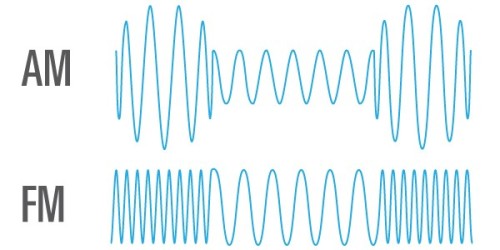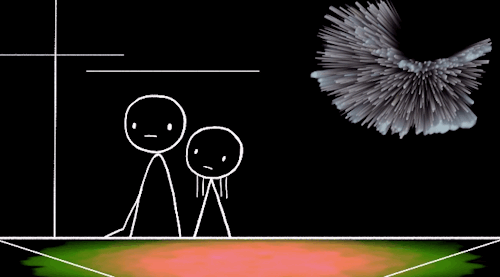Thekrishankumar - Krishan Kumar

More Posts from Thekrishankumar and Others






Adobe Photoshop is 25 years old today.
Five TED Talks that converge the worlds of art and tech
Here’s Olafur Eliasson on the nature of human perception…
Be inspired by our other selection…

AM & FM: How Radio Works
Lately I’ve been thinking about how the things I use every day actually work, and since I listen to a lot of podcasts, you can guess where this post is going: radio.
In a studio, a microphone converts sound waves from a person’s voice into an electronic audio signal. If this was sent out by itself, it would only travel a few metres in air before it faded out. To get radio waves to travel long kilometres to a receiver, we have to combine it with a “carrier wave”—an electromagnetic wave.
Electromagnetic waves are made up of oscillating electric and magnetic fields, just like visible light, but radio waves are right down on the lower end of the spectrum, so their wavelengths are very long—around 300 metres.

(Image Credit: NASA)
Sound information is combined with the wave by altering or modulating the wave’s properties, like changing its amplitude, frequency, or phase. There are two ways to combine the audio signal with the carrier wave: amplitude modulation (AM) or frequency modulation (FM).
AM radio changes the overall amplitude or strength of the wave, varying its height in order to incorporate the sound information. FM radio works a little differently, because it changes the frequency of the wave rather than the amplitude. The frequency is the number of wavelengths that pass by a given point per second—physically, a high frequency wave would look squashed up, and a low frequency wave would look stretched out.

(Image Credit: Wikimedia Commons)
Both kinds of waves are susceptible to variations in amplitude as they zoom off through the air, but since FM radio relies on changes in frequency rather than amplitude, these variations don’t matter—they can just be ignored, and so the sound quality is usually super clear. But AM radio relies on the amplitude to convey information, so when the amplitude is varied a bit, this results in interference or static, which will be a familiar idea if you’ve ever listened to AM radio on a rural country road. The upside of AM radio is that it travels much further than FM radio, which is probably why you’re listening to it on that rural country road in the first place.
So once these radio waves—whether AM or FM—hit a radio receiver, their oscillating fields induce a current in the conductor. The sound information encoded into the waves can be extracted, and converted back to sound waves to grace your ears with your favourite music or talk show.
(Bonus: if you want to use science to learn more cool science, my fave podcasts are Radiolab, the Infinite Monkey Cage, and Big Picture Science.)







Marvel & DC Ultralight
By Bunka
Adventures in the United Kingdom

Study Abroad If you were asked to spend a year living in a different location, where would you choose and why?
One of my favourite countries in the world are the United Kingdom and France. If I could study and live anywhere in the world, it would be the UK.
For some reason, the more I read about the it, the more I want to be there. I was always fascinated about travelling to other places from my country and the UK was on top of my list.
I really like how they have preserved much of their history and buildings which in my eyes are really beautiful. I always liked places or cities which are modern but with a classic look like London.
And the UK has some of the best Universities in the world such as Oxford and so on. I hope I’ll have the capacity to study there one day.





"World of Tomorrow," the new animated short by Don Hertzfeldt, promises to be one of the best sci-fi movies in years — if the first trailer is any indication.




-
 maracuchix reblogged this · 1 year ago
maracuchix reblogged this · 1 year ago -
 u-gotthelove reblogged this · 2 years ago
u-gotthelove reblogged this · 2 years ago -
 beautyisbliss reblogged this · 5 years ago
beautyisbliss reblogged this · 5 years ago -
 beautyisbliss reblogged this · 6 years ago
beautyisbliss reblogged this · 6 years ago -
 laviemorose liked this · 6 years ago
laviemorose liked this · 6 years ago -
 linger-here reblogged this · 6 years ago
linger-here reblogged this · 6 years ago -
 beautyisbliss reblogged this · 7 years ago
beautyisbliss reblogged this · 7 years ago -
 beautyisbliss liked this · 7 years ago
beautyisbliss liked this · 7 years ago -
 kayla-w13 liked this · 7 years ago
kayla-w13 liked this · 7 years ago -
 kenfuentes-blog liked this · 7 years ago
kenfuentes-blog liked this · 7 years ago -
 tusourpatchkid reblogged this · 8 years ago
tusourpatchkid reblogged this · 8 years ago -
 megascolia reblogged this · 8 years ago
megascolia reblogged this · 8 years ago -
 pos1tivevibration reblogged this · 8 years ago
pos1tivevibration reblogged this · 8 years ago -
 queridamo reblogged this · 8 years ago
queridamo reblogged this · 8 years ago -
 ohnostiletto liked this · 8 years ago
ohnostiletto liked this · 8 years ago -
 bombyle reblogged this · 8 years ago
bombyle reblogged this · 8 years ago -
 criquets liked this · 8 years ago
criquets liked this · 8 years ago -
 adeliemartinphotographie liked this · 8 years ago
adeliemartinphotographie liked this · 8 years ago -
 buketayguney reblogged this · 8 years ago
buketayguney reblogged this · 8 years ago -
 carlosands reblogged this · 8 years ago
carlosands reblogged this · 8 years ago -
 paradoxicalteen reblogged this · 8 years ago
paradoxicalteen reblogged this · 8 years ago -
 sorizaga reblogged this · 8 years ago
sorizaga reblogged this · 8 years ago -
 gloombog liked this · 8 years ago
gloombog liked this · 8 years ago -
 elegance-and-etiquette reblogged this · 8 years ago
elegance-and-etiquette reblogged this · 8 years ago -
 fabaian liked this · 8 years ago
fabaian liked this · 8 years ago -
 fabaian reblogged this · 8 years ago
fabaian reblogged this · 8 years ago -
 nomeimportatejuro reblogged this · 8 years ago
nomeimportatejuro reblogged this · 8 years ago -
 str-ambo reblogged this · 8 years ago
str-ambo reblogged this · 8 years ago -
 masamihoshino liked this · 8 years ago
masamihoshino liked this · 8 years ago -
 berylxrae liked this · 8 years ago
berylxrae liked this · 8 years ago -
 occupyinsanity reblogged this · 8 years ago
occupyinsanity reblogged this · 8 years ago -
 thewitchglitch liked this · 8 years ago
thewitchglitch liked this · 8 years ago
16, I love Technology & Science Stuff . krishan@krishankumar.me
82 posts